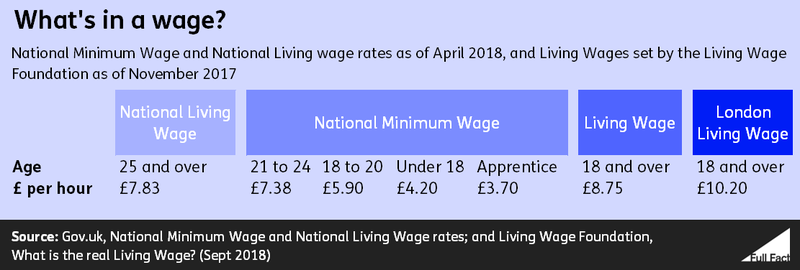The Rates: National Minimum Wage, National Living Wage and Living Wage
Join 72,547 people who trust us to check the facts
Subscribe to get weekly updates on politics, immigration, health and more.
Q. What is the National Minimum Wage?
A. The National Minimum Wage is the minimum pay per hour to which most workers aged 16 to 24 are entitled. The government reviews these rates every year and is advised on the level to set the minimum wage at by the Low Pay Commission. This is an independent advisory body made up of employers, trade union leaders and academics.
There are different levels of minimum wage that a worker will receive depending on their age (once they turn 16) and a lower rate for apprentices. It’s £7.38 an hour for those aged 21-24, £5.90 for those aged 18-20, £4.20 for those under 18, and £3.70 for apprentices.
The minimum wage for workers 25 and over is called the National Living Wage.
The reason the Low Pay Commission gives for having different levels of wage depending on your age is that there is “evidence that younger workers are more at risk of being priced out of jobs than older workers, with worse consequences if they end up unemployed.”
Q. What is the National Living Wage?
A. The National Living Wage is the legally binding hourly rate for workers aged 25 and over. It was set at £7.83 an hour in April 2018 and is reviewed every year just like the National Minimum Wage.
The National Living Wage is distinct from the Living Wage, which is the level of pay recommended by the Living Wage Foundation, an independent campaign group. This is paid voluntarily by employers that choose to pay it and is higher than the government’s National Living Wage.
The National Living Wage was announced in the 2015 Summer Budget and set at £7.20 for workers over the age of 25. It came into force on 1 April 2016. Then it was worth around 55% of median hourly earnings—that’s the hourly wage that would be in the middle if everyone in the country had their paychecks lined up.
Last year the government said it had a target for the National Living Wage to amount to 60% of median earnings by 2020. The latest forecast suggests that the National Living Wage will be £8.57 by 2020.
Q. What is a living wage? What is the London living wage? What is a living wage employer?
A. There are two ways to talk about a living wage. There is the National Living Wage, as we’ve discussed above and which is set by the government. Then there is the voluntary Living Wage recommended by the Living Wage Foundation, which is higher than the National Living Wage.
The Living Wage Foundation’s rate is calculated each year by the Resolution Foundation, and is based on the cost of achieving an adequate standard of living.
The current recommendation for a UK living wage is £8.75 per hour outside London, for all workers aged 18 and over.
The living wage for London is £10.20 per hour, which reflects the higher cost of housing, childcare and transport needs of workers living in the city.
Unlike the National Living Wage and National Minimum Wage this rate is not legally enforceable. However, over 4,000 organisations have signed up as accredited living wage employers, ranging from FTSE 100 companies and some large local authorities to small businesses and charities.
Q. What is the difference between the minimum wage and the living wage?
A. The difference between the National Minimum Wage and the National Living Wage varies depending on how old you are, where you live and which living wage you compare it to.
There is a difference of 45p to £4.13 per hour between the National Living Wage set by the government for people aged 25 and over, and the National Minimum Wage for people under 24. The largest difference comes from comparing the National Minimum Wage rate for apprentices to the National Living Wage, and then the gap gets smaller as people get closer to 25.
The Living Wage set by the Living Wage Foundation is only intended for people over the age of 18, so we’ll only compare it to the government wage rates for those aged 18 plus.
In London, the difference between the Foundation's Living Wage and the National Minimum Wage or National Living Wage is between £2.37 and £4.30 per hour. Across the rest of the UK the difference is between 92p and £2.85 per hour depending on how old you are.

A. The National Living Wage and the National Minimum Wage rates are changed every April.
The voluntary Living Wage rates are announced at the start of November each year. The Living Wage Foundation says accredited employers should start paying the new rate as soon as possible and within six months of it being announced.
Q. Are the minimum wage and living wage fixed in law?
A. There are two legally enforced pay rates for workers: the National Minimum Wage and the National Living Wage.
The National Minimum Wage was first introduced by the National Minimum Wage Act 1998 and added to with the National Minimum Wage Regulations 2015. A new law each year updates the rates.
The National Minimum Wage (Amendment) Regulations 2016 introduced the National Living Wage from April 2016.
Both the National Minimum Wage and the National Living Wage are enforced by Her Majesty’s Revenue and Customs (HMRC). Workers can ask Acas (Advisory, Conciliation and Arbitration Service) to help if they think they’re being underpaid or complain to HMRC.
The Living Wage set by the Living Wage Foundation is not fixed in law.